
Pain is our body’s way of telling us that something is wrong and needs to be fixed. When it’s the sciatic nerve alerting you that something’s wrong, the pain can spread anywhere throughout the bottom half of the body. It can range from being a mild nuisance to painful enough to need emergency surgery.
Unlike most back pain, sciatic nerve pain can manifest anywhere from the lower back to the feet. The pain’s intensity also varies and can be a dull ache to a sharp, burning sensation on one side.
What Is the Sciatic Nerve?
The sciatic nerve is the longest and widest nerve in the body and starts in the lower back. The nerve begins branching from the hips through the buttocks, legs and feet. It branches out because it has multiple functions, including supplying nerves to the entire lower part of both legs — the back of the knee, calves and ankles. On top of that, the sciatic nerve allows the soles of the feet, ankles, lower legs and backs of the thighs to maintain sensation.
The sciatic nerve is considered a mixed-function nerve, which means it’s responsible for both sensory and motor neurons. This nerve alone is what allows the muscles to move and helps you feel sensations. Knowing this, it’s no surprise that it can lead to intense pain and loss of ability if compromised in any way. Damage of any sort can cause sciatica nerve pain, which shows symptoms including lower back pain and muscle weakness. These symptoms mainly present in the lower leg, despite wherever the nerve itself is damaged.
What Causes Sciatica Nerve Pain?
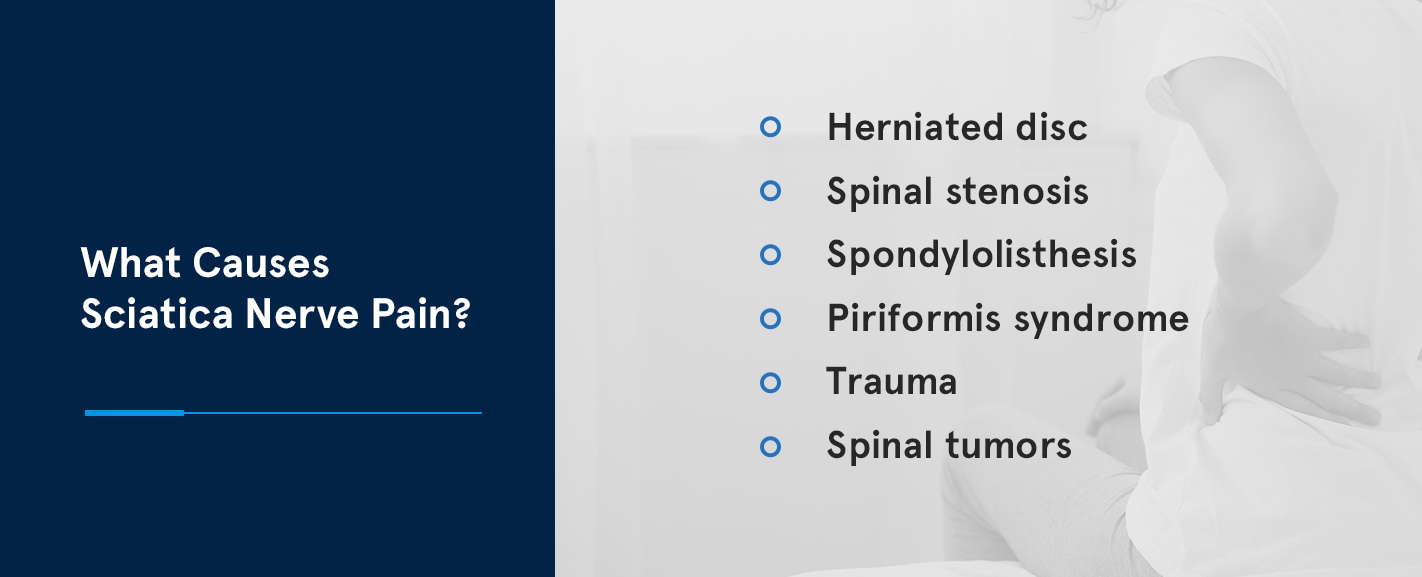
As its name suggests, sciatica nerve pain refers to the pain you feel in any part of the body through which the sciatic nerve passes. Generally, what causes sciatic nerve pain depends on how the sciatic nerve is compromised. The most common ways the sciatic nerve can be damaged are:
- Herniated disc
- Spinal stenosis
- Spondylolisthesis
- Piriformis syndrome
- Trauma
- Spinal tumors
When the nerve is damaged, pain flares up on one side and can occur anywhere between the lower back and foot. The pain’s severity, as well as its cause, will determine what sort of treatment is best.
Herniated Disc
A herniated or bulging disc is the most common cause of sciatic nerve pain. The spinal cord consists of discs, which cushion the vertebrae to keep the bones from grinding against each other. When this cushioning disc slips out of the crack in its outer casing, it can put pressure on the sciatic nerve, causing discomfort and pain.
Generally, a herniated disc results from the body naturally aging, which happens slowly over time. But you can develop a herniated disc at any age from everyday chores, like lifting heavy objects incorrectly.
Spinal Stenosis
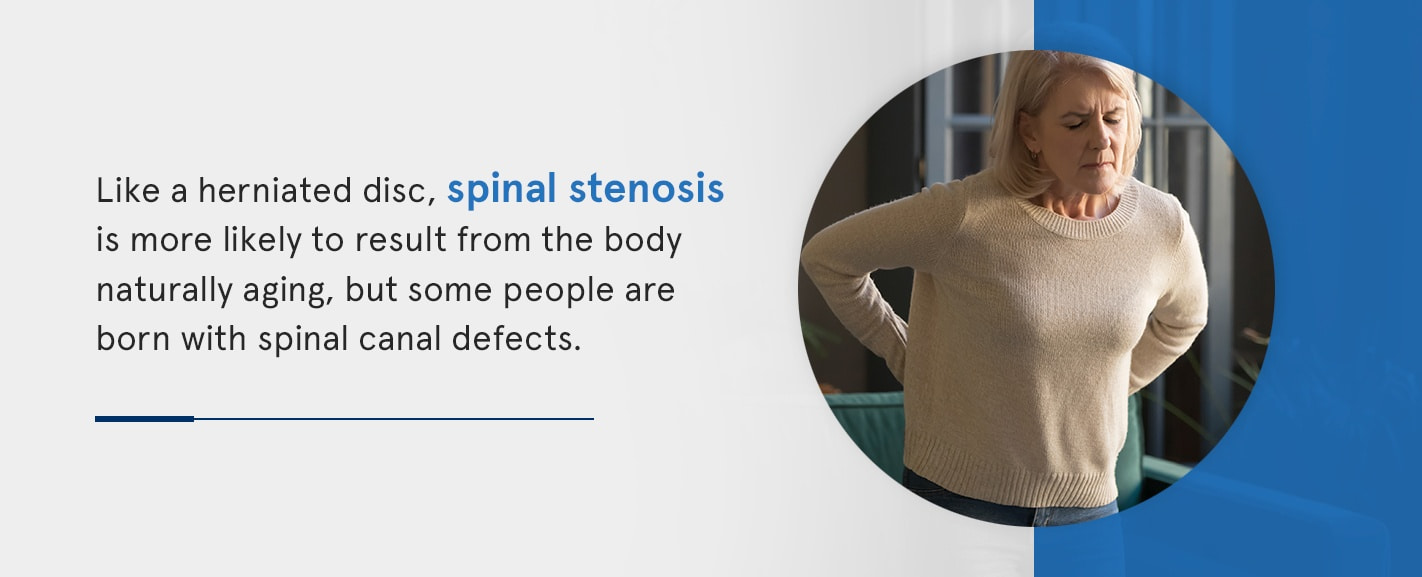
Lumbar spinal stenosis results from your spinal canal narrowing. The spinal canal has no reason to narrow, so when this abnormal event occurs, it puts undue pressure on the roots of the sciatic nerve. Like a herniated disc, spinal stenosis is more likely to result from the body naturally aging, but some people are born with spinal canal defects.
When the spinal canal narrows, the nerve pain that results tends to be tingly or numb due to the pressure put on the spinal nerve roots.
Spondylolisthesis
Another potential cause for sciatic nerve pain is spondylolisthesis, which happens when one of the lower vertebrae slips to the bone beneath it. It’s another condition linked to the body’s natural aging and degradation, and it can become extremely painful because of the undue pressure the slipped vertebra puts on the nerve roots. Luckily, spondylolisthesis is a simple disease to treat using therapy or surgery, depending on the severity of the condition.
Ensuring a healthy lifestyle with proper exercise can help prevent spondylolisthesis from occurring altogether.
Piriformis Syndrome
If you’re wondering what causes sciatic nerve pain in the buttocks, the answer is likely piriformis syndrome. The piriformis muscle is located in the buttocks and connects the spine to the top of the thighbones. This muscle enables your body to rotate your hips and move your legs and feet outward. The piriformis muscle sits directly on top of the sciatic nerve — but the nerve may even run right through this muscle for some people.
The muscle’s proximity to the sciatic nerve is what makes piriformis syndrome likely. When the piriformis muscle involuntarily contracts or tightens, it inevitably puts pressure on the sciatic nerve, causing sciatica. The condition is made worse by sitting for long periods. Piriformis syndrome is a rare disorder, and its causes are unknown.
A sciatica diagnosis is common when the condition manifests as pain in the legs and thighs, but symptoms of piriformis syndrome can also present as a dull pain in the buttocks, limited range of hip motion and pain when climbing stairs.
Trauma
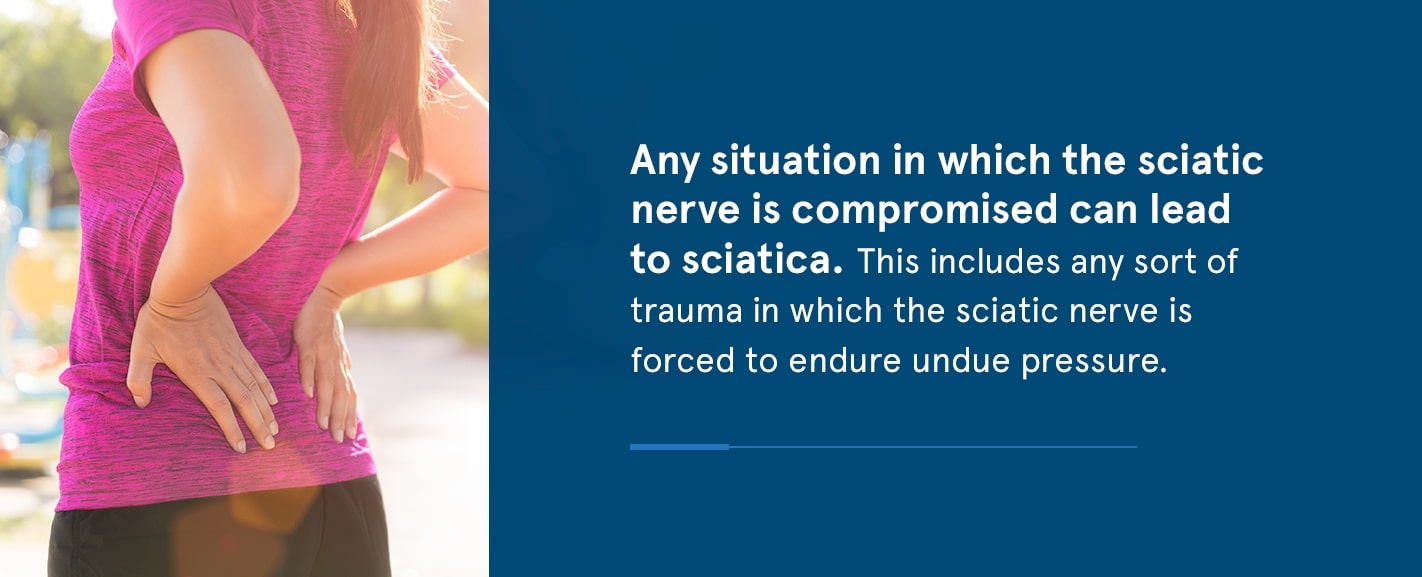
Any situation in which the sciatic nerve is compromised can lead to sciatica. This includes any sort of trauma in which the sciatic nerve is forced to endure undue pressure. Different causes can include events like sports accidents, car accidents, trips or falls and even instances of broken bones. All these traumas can impact the sciatic nerve and damage or compress it.
Spinal Tumors
In rare cases, a person may experience sciatic nerve pain because of a tumor pressing on the nerve. However, cancer isn’t always to blame. Even benign tumors are still abnormal growths that can damage the sciatic nerve. Luckily, benign tumors can be easily removed with surgery and are unlikely to leave any lasting damage to the nerve.
Malignant tumors are a possibility, and they grow in the vertebral column from the bone or disc area, once again threatening pressure to the sciatic nerve.
What Causes Sciatica Nerve Pain to Flare Up?
Knowing what causes sciatic nerve pain in the lower back or hip can go a long way in helping you avoid the discomfort of a sciatica flare-up. While any of the aforementioned conditions can cause sciatica, the pain isn’t nonstop. Most people have certain triggers that encourage flare-ups, and knowing what those triggers are can help prevent sciatic nerve pain from getting worse. Some common causes of sciatic nerve pain flare-ups include:
- Stress
- Poor posture
- Tight clothing or uncushioned shoes
- Excessive weight
- Sedentary Lifestyle
- Pregnancy
Understanding the pattern helps you figure out what causes sciatic nerve pain in the hip and lower extremities and how to best avoid it.
Stress
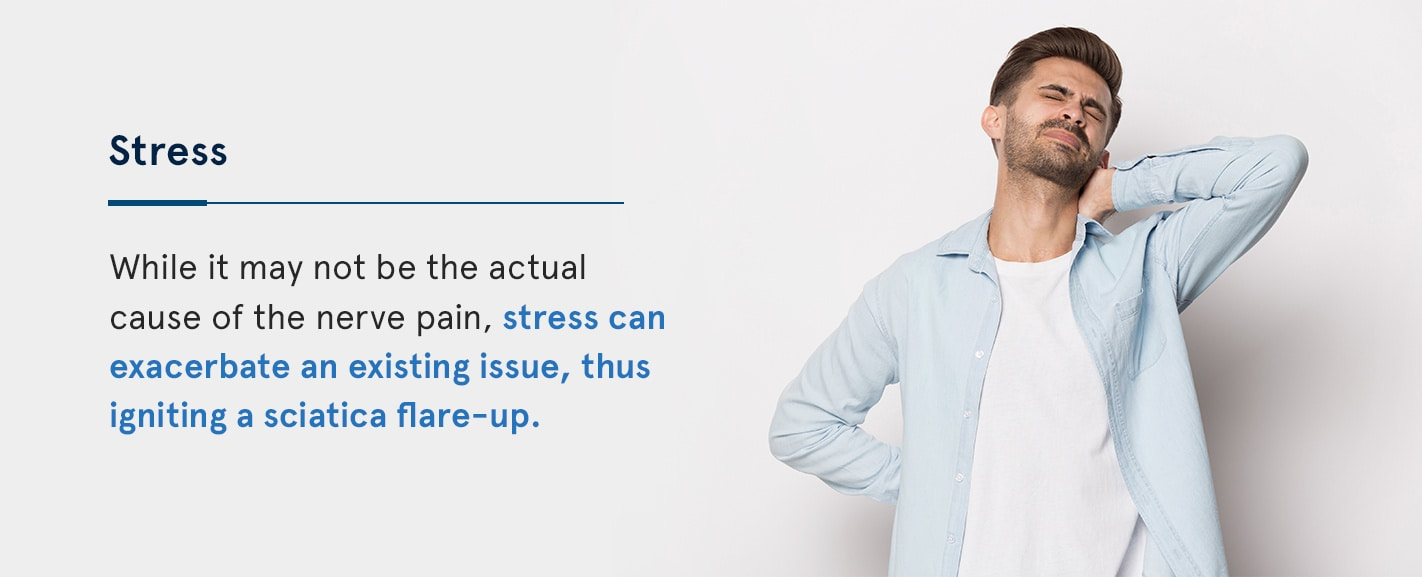
As we learn more about how the body reacts to stress, we see the correlation between stress and many mental and physical conditions, including sciatica. While it may not be the actual cause of the nerve pain, stress can exacerbate an existing issue, thus igniting a sciatica flare-up. Similarly, negative emotions like sadness and conditions like depression can also indirectly facilitate a nerve pain flare-up.
Poor Posture
Unsurprisingly, poor posture is a common cause of sciatica flare-ups due to the potential pressure bad posture puts on the lower back. That extra pressure can damage the sciatic nerve, irritating it and leading to sciatica-related pain.
Similarly, improper body alignment is also a potential cause for a sciatica flare-up. Sitting with a hunched back is one thing, but walking around with stooped shoulders and a curved spine is contrary to how the body should function, and sciatic nerve pain signals that something isn’t right.
Tight Clothing or Uncushioned Shoes
For some people, wearing clothes that are too tight around the sciatic nerve can put undue pressure on it, causing nerve pain. This includes clothing such as jeans or underwear with tight elastic waists. Similarly, high heels of any sort are designed in a way that forces the body to hunch forward at the hips. Wearing heels or any shoes without proper cushioning forces the back or hips to take the brunt of the impact of every footstep.
Hunching the hips forward and transferring the impact of footsteps to the back or hips can lead to a pulled hamstring, which is a muscle located next to the sciatic nerve. The pulled muscle, again, puts undue pressure on the nerve, causing it to become irritated.
Excessive Weight
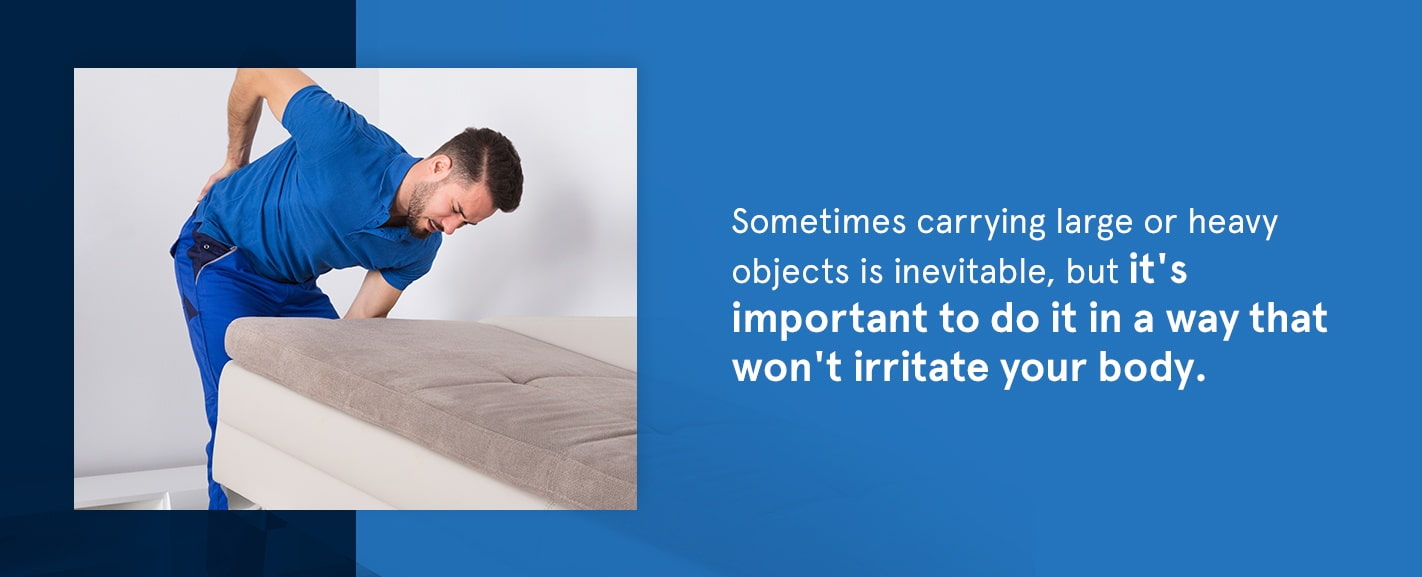
Sometimes carrying large or heavy objects is inevitable, but it’s important to do it in a way that won’t irritate your body. Similarly, if you put added pressure on your lumbar region with everyday activities that require you to bend at the hip, you’re making your back do a lot of work. The lumbar discs have to work extra hard to keep up, and when overworked, they are at a bigger risk of slipping out, causing a herniated disc.
Sedentary Lifestyle
The disadvantages of a sedentary lifestyle are well known, but the risk of sciatica is another reason to incorporate a little physical activity in your day-to-day life. If your job requires you to stay seated for extended periods, you may have to find ways to get your body moving, whether exercising before work or opting for a standing desk.
If the latter isn’t an option, and you have no choice but to sit for extended periods, avoid having any hard objects in your back pockets, such as a wallet, keys or smartphone. These objects can irritate the piriformis muscle, which is located just above the sciatic nerve.
Pregnancy
Those who may have had no reason to worry about sciatica in the past may become unlikely victims of sciatic nerve pain when they become pregnant. During pregnancy, sciatic nerve pain can be triggered by developing piriformis syndrome, which is when the piriformis muscle in the buttocks contracts and irritates the sciatic nerve underneath it.
What causes sciatic nerve pain during pregnancy is the weight of the growing fetus. This weight forces the pelvis to move forward, which causes the piriformis muscle to tighten and put pressure on the sciatic nerve.
Frequently Asked Questions About Sciatica
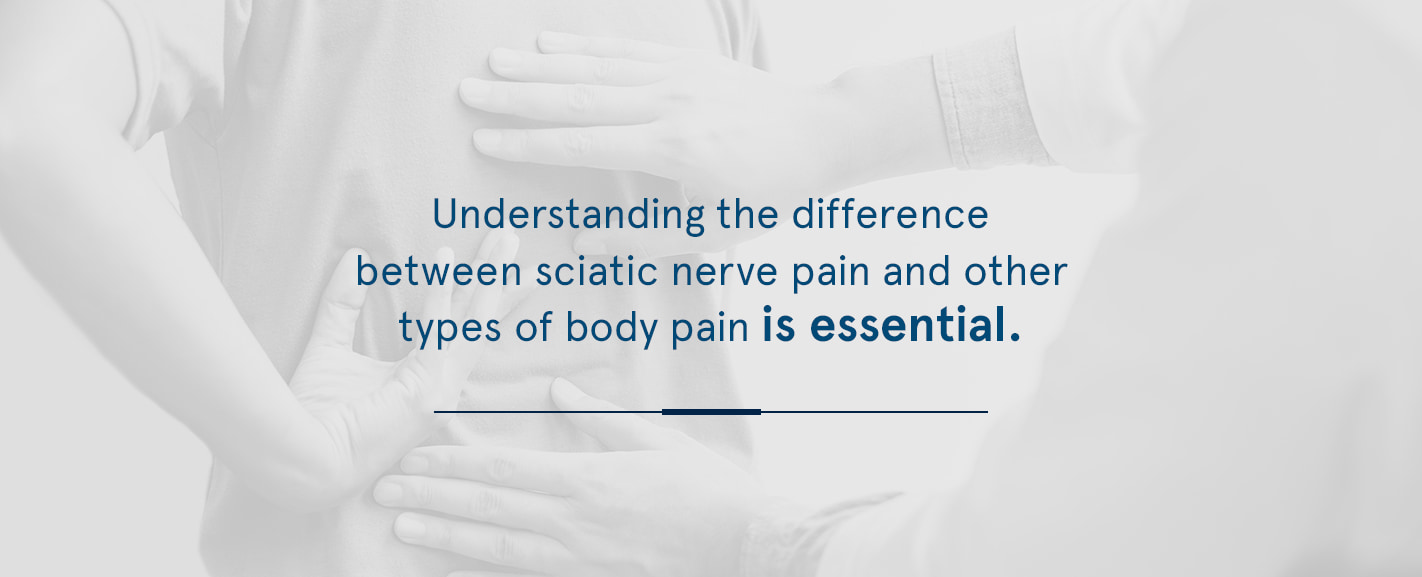
Even after knowing the reasons for sciatica and identifying the triggers, you may still have certain lower body pain that may or may not be related to the sciatic nerve. Understanding the difference between sciatic nerve pain and other types of body pain is essential. While what causes sciatic nerve pain in pregnancy is often an easy answer, causes for other nerve pain issues in the lower back, hips and legs may be more difficult to pinpoint.
Can Sciatica Cause Severe Pain in Your Legs and Ankles?
Since the sciatic nerve is long enough to perform functions for the nerves and muscles in the lower back, buttocks and both legs and feet, sciatica will likely present as pain in the leg. Usually, sciatica is most common on one side — meaning you’re unlikely to feel pain in both legs at the same time — and can be constant or occasional. It’s usually a sharp, shooting pain, which can be severe, but it can also present as a burning sensation.
While the ankle itself is less likely to feel the same level of pain as the calf or shin, some people may feel numbness around the ankle and even experience weakened muscles in that area.
How Do You Relieve Sciatic Nerve Pain?

More often than not, sciatica pain relief doesn’t require surgery, and the pain can be cured with several at-home or over-the-counter remedies. Physical therapy, medications, therapeutic injections and alternative therapies are some of the first ways to treat sciatic nerve pain and, if successful, will alleviate the symptoms within four to six weeks. If you know what triggers your sciatica, stopping that activity will also help relieve the pain, and, in some cases, gently stretching the sciatic nerve may help alleviate initial pain.
Here are some common ways to treat sciatica:
- Physical therapy: A customized stretching and exercise routine created by a physical therapist is one of the best ways to alleviate sciatica pain. It will improve your posture and gently remove pressure from the sciatic nerve.
- Exercise: Sometimes, you can reduce the amount of inflammation with some physical activity, such as short walks.
- Bed rest: For some people, simply resting is enough to alleviate the pain and take the pressure off the sciatic nerve. However, it’s important to limit the amount of time you rest and ensure you’re resting on a firm surface, whether it’s a mattress or the floor.
- Hot and cold packs: At the onset of sciatic nerve pain, a cold pack can reduce any potential swelling. Simply apply it to the painful area for a few minutes a few times every day. After the first couple of days, switch to a heat pack, following the same routine.
- Alternative therapies: For some people, alternative therapies such as yoga, massages and acupuncture work best. If you’ve had success with alleviating sciatica pain with alternative therapies, there’s no reason to stop if it works for you.
- Medication: For most people, the way they get their sciatic nerve to stop hurting is over-the-counter pain relievers. These are the first thing you should consider when using medication to lessen sciatica pain. For more severe cases, your doctor may prescribe a muscle relaxant or other pain medication.
In less common cases, surgery may be needed to treat sciatica successfully. Surgery is always a last resort, and your physician will always opt for non-invasive treatments first. However, in some cases, the sciatica is severe enough to require immediate surgery, such as if the nerve pain is accompanied by loss of bowel or bladder control.
There are two types of surgery for sciatic nerve pain:
- Diskectomy: When the cause of the sciatica is obvious, such as a herniated disc or bone spur, a surgeon may opt for a diskectomy to remove nothing but the object compromising the sciatic nerve. In some cases, the surgeon may need to remove the disc itself, but in either scenario, it will likely be an outpatient surgery.
- Laminectomy: In this type of surgery, the surgeon removes the lamina — a part of the bone covering the spinal cord — along with any tissue that may be pressing on the sciatic nerve. This surgery may be an outpatient procedure or may require you to spend the night in the hospital. Upon your release, your doctor will provide you with instructions on how to walk as you recover.
How Long Does Acute and Chronic Sciatica Last?
The duration of sciatic nerve pain directly links to whether it’s acute or chronic.
Acute sciatica pain tends to come and go and can last anywhere from one to two weeks. More often than not, simple at-home remedies are enough to alleviate acute sciatica within a few weeks. These episodes may only occur a few times a year.
On the other hand, chronic sciatica pain doesn’t go away. Acute sciatica can turn chronic, causing constant but often less severe pain. Chronic sciatica, unlike acute sciatica, tends to be a lifelong condition and there are no definite cures for it.
Therefore, prevention is often much better concerning sciatic pain, especially if you find yourself experiencing acute pain several times a year.
Does Sciatic Nerve Pain Cause Swelling in the Legs?
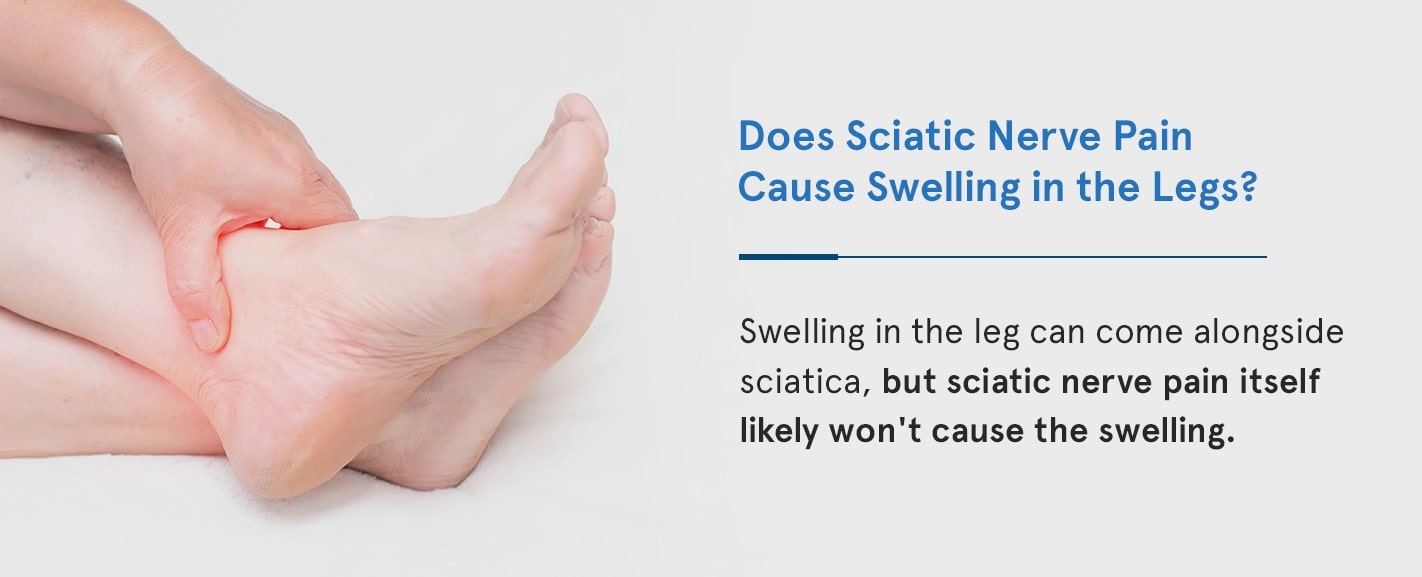
Swelling in the leg can come alongside sciatica, but sciatic nerve pain itself likely won’t cause the swelling. However, the cause of sciatica may be a culprit if you find your lower extremity swollen. If you develop sciatica from an injury — such as a pulled muscle from lifting something heavy — you might experience swelling and, depending on where the swelling is, it may press on the sciatic nerve, causing it to become compressed. That compression is what may cause sciatic nerve pain in that area.
How Do You Manage Sciatica Pain?
The best way to manage sciatic nerve pain is to identify its cause and triggers first. Once you know what causes flare-ups, avoid or limit those activities. If a flare-up occurs, simple self-care remedies, like exercise and over-the-counter painkillers, are the best course of action, though simple rest is also a good idea. However, it’s important to be careful when resting after a sciatica flare-up since too much rest can make it harder to resume normal activity.
If you’re experiencing swelling, cold packs are great to reduce this, and hot packs will help the blood flow once the swelling goes down.
When Should You See a Doctor for Sciatic Nerve Pain?
Most sciatica symptoms will go away with self-care, but if the pain persists for more than a few weeks despite this, it may be a good idea to see your doctor. Even if you’re used to sciatica flare-ups, if you experience an episode in which the pain is more severe than before, schedule a visit to your doctor to figure out what’s different this time.
Head to the emergency room if you’re having trouble maintaining control over your bowels or bladder, or if you’ve experienced a trauma, like an accident, just before the flare-up.

Find Professional Care at OrthoBethesda
When it comes to diagnosing and treating pain like sciatica, the highly skilled team at OrthoBethesda is ready to help. We pride ourselves on our years of experience and our exceptional patient care. We make sure you understand why your body is expressing pain and help you learn how to best alleviate it, so you can live your life to the fullest.
If you live in Bethesda, Arlington or anywhere in the Washington, D.C., metropolitan region, let OrthoBethesda help you live a pain-free life. To schedule an appointment, please contact us by calling (301) 530-1010.
Related Content
- How to Prevent Back Pain When Working From Home
- How to Reduce Low Back Pain
- How to Sleep After Back Surgery
- 10 Steps to Achieving Better Posture
- How to Sleep With a Herniated Disc
- How to Know if You Have a Herniated Disc
- Spinal Fusion Surgery – Commonly Asked Questions
- Spine Surgery: When It Works and When It Doesn’t
- Dr. Eric Feuchtbaum Makes Advancements in Minimally Invasive Spine Surgery With Mazor Robotics
- What Is Kyphosis?
- Everything to Know About Scoliosis
